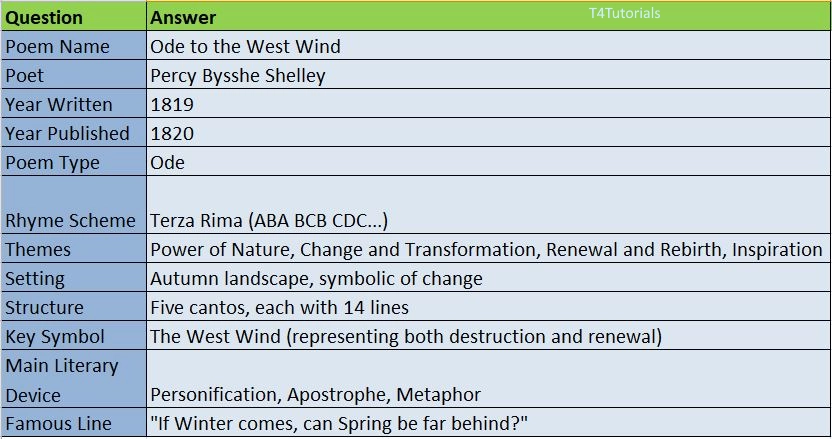Summary:
Ode to the West Wind is one of Percy Bysshe Shelley’s most famous poems, written in 1819 and published in 1820. It is an ode celebrating the power of the West Wind as a force of change and renewal. The poem is divided into five cantos, each consisting of 14 lines, and follows the terza rima rhyme scheme.
Shelley personifies the West Wind as a mighty and uncontrollable force that can bring both destruction and rebirth. He describes its impact on the earth, sky, and sea, showing its ability to clear away the old and make way for the new. The poet sees himself as weak and struggling, wishing that the West Wind could inspire him to create powerful poetry that would influence the world.
The poem ends with the hopeful question: “If Winter comes, can Spring be far behind?” suggesting that no matter how dark or difficult times may seem, renewal and change are always possible. This final line symbolizes hope, transformation, and the continuous cycle of life.

Score: 0
Attempted: 0/10
Subscribe
| Question | Answer |
| Poem Name | Ode to the West Wind |
| Poet | Percy Bysshe Shelley |
| Year Written | 1819 |
| Year Published | 1820 |
| Poem Type | Ode |
| Rhyme Scheme | Terza Rima (ABA BCB CDC…) |
| Themes | Power of Nature, Change and Transformation, Renewal and Rebirth, Inspiration |
| Setting | Autumn landscape, symbolic of change |
| Structure | Five cantos, each with 14 lines |
| Key Symbol | The West Wind (representing both destruction and renewal) |
| Main Literary Device | Personification, Apostrophe, Metaphor |
| Famous Line | “If Winter comes, can Spring be far behind?” |